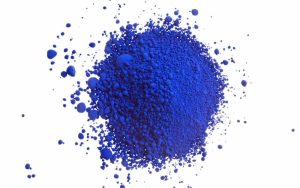 BLUE/BLEU
BLUE/BLEU
Intersecting Worlds of Colour in the 18th Century
Les mondes croisés de la couleur au XVIIIe siècle
An Interdisciplinary Workshop / Une journée d’étude
Organisée par Charlotte Guichard (CNRS/ENS-PSL), Anne-Solenn Le Hô (C2RMF/Chimie ParisTech-PSL), Hannah Williams (Queen Mary University of London).
6 Sept 2019- 9h00-17h30
Salle Walter Benjamin, INHA
2 Rue Vivienne, 75002 Paris
PROGRAMME
9h00-9h20 Accueil
9h20-9h30 Ouverture – Sigrid Mirabaud (INHA)
9h30-11h00
Bleu de Prusse : les histoires d’une couleur.
Le projet ‘PaintItBlue’ en contexte.
Charlotte Guichard (CNRS / ENS-PSL),
Le bleu de Prusse comme « objet frontière »
Anne-Solenn Le Hô (C2RMF / Chimie ParisTech, PSL),
Le bleu de Prusse comme produit chimique
Hannah Williams (Queen Mary University of London),
Le bleu de Prusse comme matériau artistique
11h00-11h20 Pause café
11h20-13h00
Session 1 – Couleur : Art et Chimie
(Modérateur : Michel Menu, C2RMF / Chimie ParisTech, PSL)
Myriam Eveno (C2RMF / Chimie ParisTech, PSL),
La palette de Watteau et de ses épigones : l’analyse des pigments bleus
Alexandra Gent (National Portrait Gallery, Londres),
Turchino, Azzurro, Blue : Joshua Reynolds’s use of blue pigments
13h00-14h30 Déjeuner
14h30-16h30
Session 2 – Couleur : Historicité et Matérialité
(Modérateur : Guillaume Faroult, Musée du Louvre)
Sven Dupré (Artechne ERC, Universiteit Utrecht),
Re-working Recipes, Reconstructing Colour Worlds
Marguerite Martin (Université Paris 1 Panthéon Sorbonne),
Indigo : de la construction des savoirs sur un produit exotique à la définition commerciale du produit et de ses usages
Yuriko Jackall (Wallace Collection, Londres),
Greuze’s Greens : Colour and biography in eighteenth-century Paris
16h30-17h30 Cocktail
Pigments, paints, and dyes. Made from organic and inorganic materials, derived from natural substances or synthetic processes, these chemical products are responsible for every artwork ever painted, drawn, printed, or woven. In the eighteenth century, at a moment just before the mass production and marketization of artists’ materials, colour became a vibrant space for scientific invention, artistic experimentation, technological advancement, and commercial success. Blue in particular – from Indigo to Prussian Blue – became a site of energetic entrepreneurship and innovation, leading from the macrocosms of global trade and the international circulation of scientific knowledge, to the microcosms of the laboratory, factory, shop, and studio. Encompassing a diverse range of actors, objects, and spaces, the intersecting worlds of colour present a fascinating space for inquiry into eighteenth-century relationships between art, chemistry, commerce, and industry, and into the materials, practices, and economies that brought them together.
Taking ‘blue’ as its focus, this workshop will explore the artistic, scientific, and social histories of colour in the eighteenth century, and above all, the intersections between them. What happens when artists’ colours are considered as interdisciplinary substances? What relationships exist, for instance, between a colour’s physico-chemical properties, its economic values, and its aesthetic qualities? How might these materials set histories of artworks in dialogue with histories of gesture and technique, or with social histories of the ‘art world’, in Howard Becker’s sense of the term? Where is colour in these multi-layered histories, and where do their narratives meet and diverge? Attending to Tim Ingold’s injunction to “follow the materials”, this workshop seeks micro-historical engagements that recontextualise the colour blue (as a material) by tracing it through the intersecting worlds of art, science, technology, and commerce across the long eighteenth century.
Concluding a research project – PaintItBlue – on “Matériaux anciens et patrimoniaux,” funded by the Île de France region, this interdisciplinary workshop will bring together art historians, historians, curators, scientists, and conservators in an effort to prompt new conversations about the histories of artists’ materials, while shaping rich methodological terrains through which to pursue them.
This event is supported by a grant from the Ile-de-France Region – DIM “Matériaux anciens et patrimoniaux” ».

Leave a Reply
You must be logged in to post a comment.